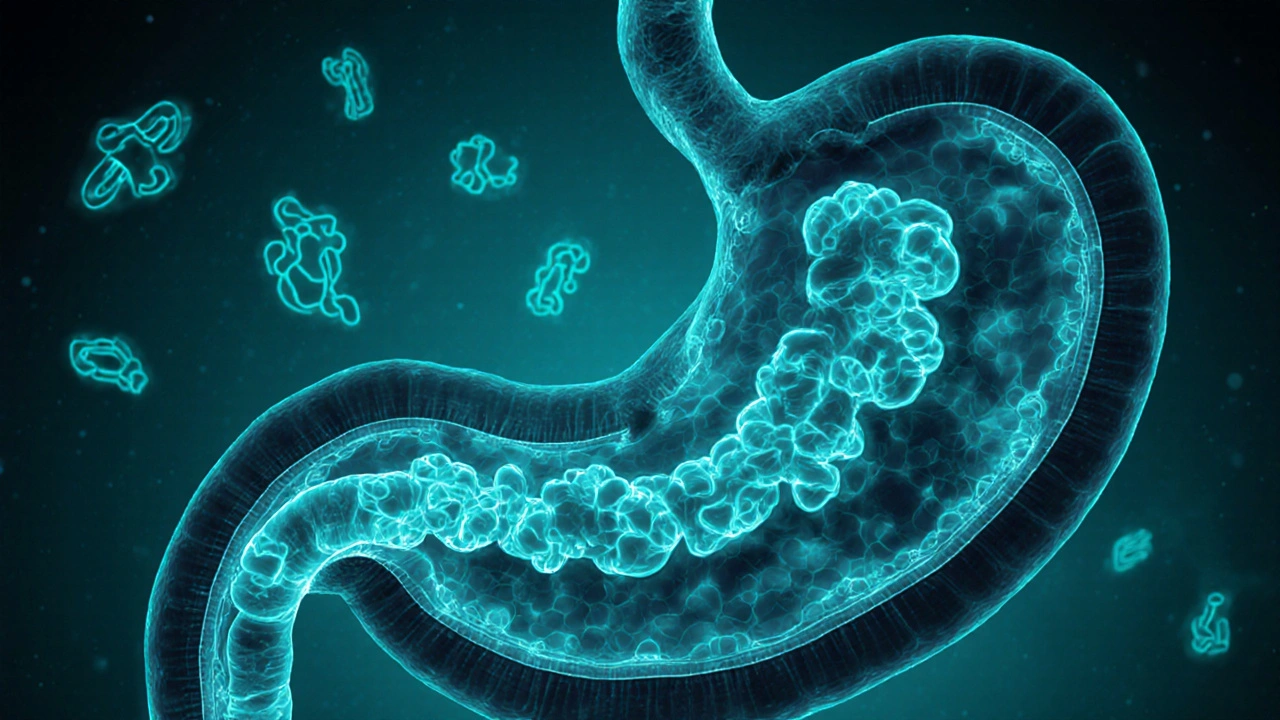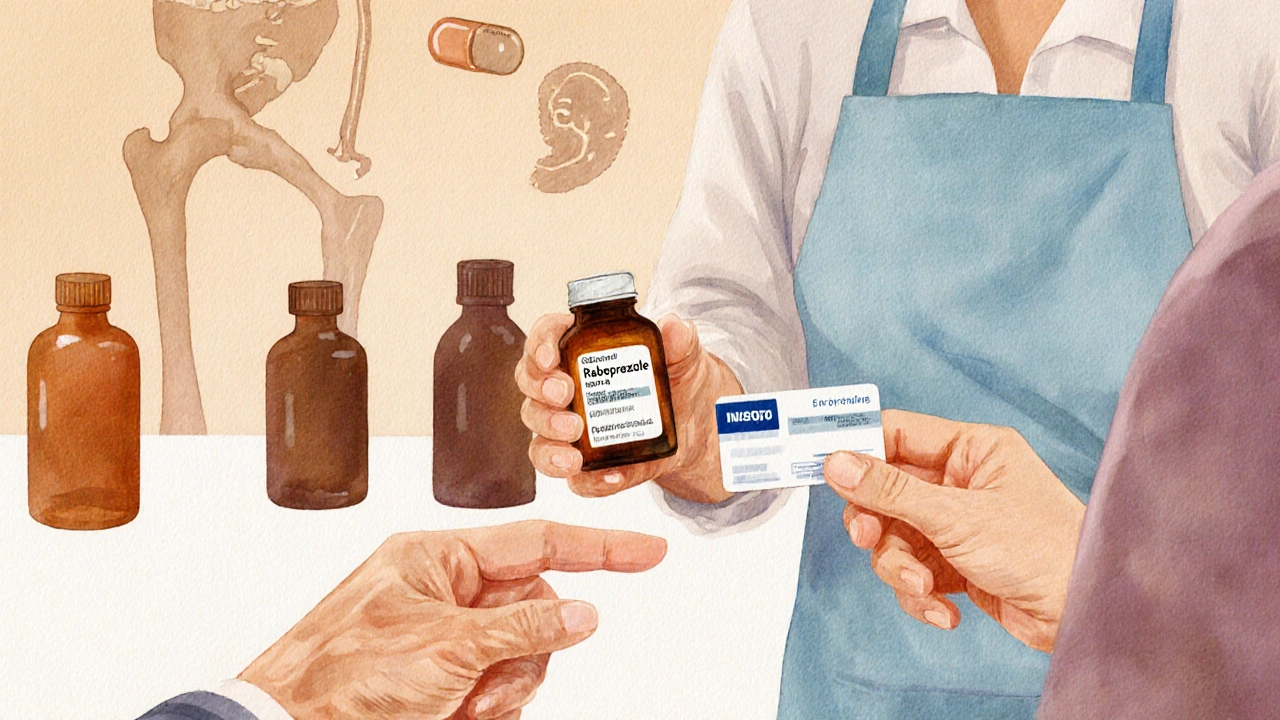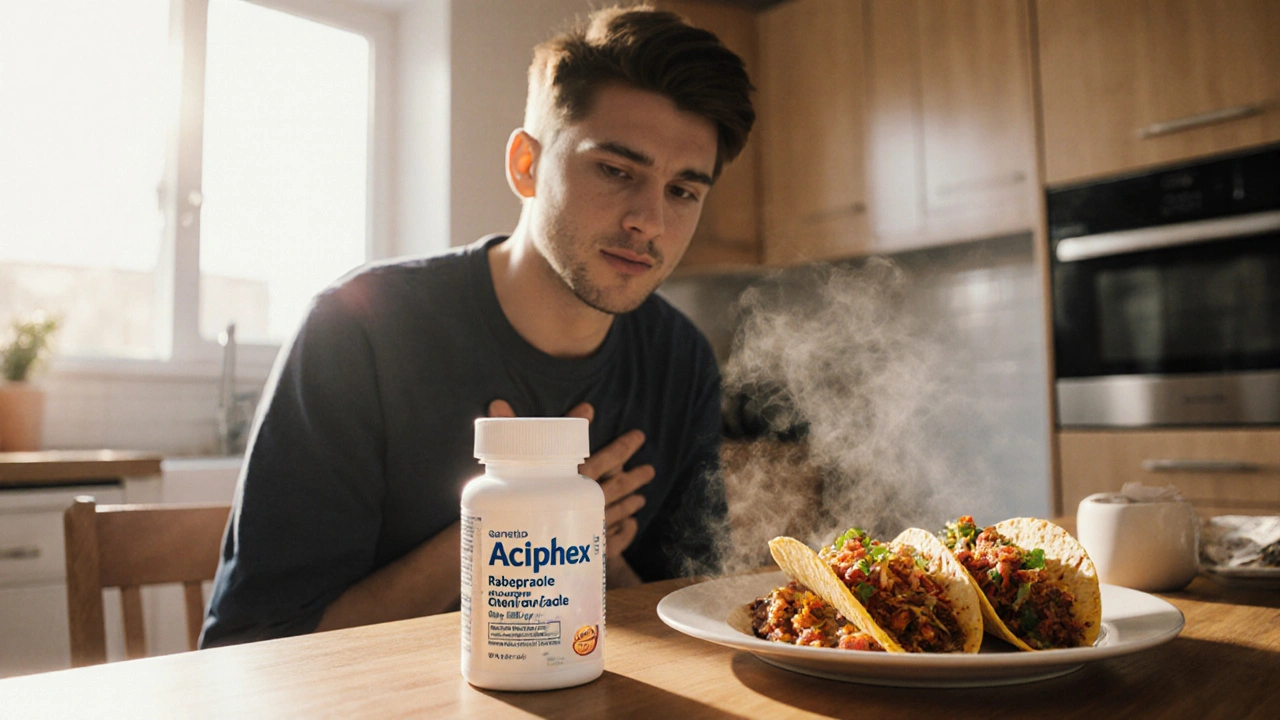PPI Selection Calculator
Find Your Best Acid Reducer
Answer a few questions to determine which acid reducer might work best for you based on your medical needs and insurance coverage.
Recommended Options
Based on your answers, here are your best options:
Key Considerations
If you’re hunting for the right medicine to tame heartburn, you’ve probably seen Aciphex described as rabeprazole, a proton pump inhibitor (PPI) that cuts stomach‑acid production.
Quick Takeaways
- Aciphex (rabeprazole) offers rapid onset and consistent acid control, especially for patients with fast metabolism.
- Omeprazole and lansoprazole are cheaper but can be affected by CYP2C19 genetic variations.
- Esomeprazole provides the most robustacid‑suppression for severe erosive esophagitis.
- H2 blockers like famotidine work fast but are less potent for chronic GERD.
- Cost, insurance coverage, and personal tolerance often decide the final pick.
How Aciphex (Rabeprazole) Works
Rabeprazole belongs to the proton pump inhibitor class. It blocks the H⁺/K⁺‑ATPase enzyme (the “pump”) in parietal cells, stopping the final step of acid secretion. Unlike some older PPIs, rabeprazole’s binding to the pump is less dependent on the cytochromeCYP2C19 pathway, meaning people who are rapid metabolizers still get full effect.

Key Attributes Compared to Other PPIs
Below is a head‑to‑head look at the most common alternatives.
| Attribute | Aciphex (Rabeprazole) | Omeprazole | Esomeprazole | Lansoprazole | Pantoprazole |
|---|---|---|---|---|---|
| Onset of action | 30-60min | 60-90min | 30-60min | 45-60min | 45-90min |
| Peak plasma time (hrs) |
2-3 | 3-5 | 2-4 | 3-4 | 3-5 |
| CYP2C19 reliance | Low | High | Moderate | High | Moderate |
| Typical dose (mg) | 20once daily | 20-40once daily | 20-40once daily | 15-30once daily | 20-40once daily |
| FDA‑approved for erosive esophagitis |
Yes | Yes | Yes | Yes | Yes |
| Common side effects | Headache, diarrhea | Headache, nausea | Headache, abdominal pain | Nausea, flatulence | Diarrhea, constipation |
The table shows why many clinicians pick rabeprazole for patients who have been labeled “CYP2C19 rapid metabolizers.” The reduced metabolic dependence translates to steadier acid control without dose escalation.
Safety Profile and Drug Interactions
All PPIs share a class‑wide safety signal: long‑term use can raise the risk of bone fractures, vitaminB12 deficiency, and Clostridioides difficile infection. Rabeprazole’s advantage is its lower propensity to interact with drugs that rely on CYP2C19, such as clopidogrel or certain antidepressants.
Clopidogrel is an antiplatelet that needs activation by CYP2C19. When taken with high‑CYP2C19‑dependent PPIs (omeprazole, lansoprazole), its effectiveness can dip by up to 30%. Rabeprazole’s weak inhibition means the interaction is clinically negligible.
Other notable interactions include:
- Ketoconazole and itraconazole - reduced absorption because these antifungals need an acidic environment.
- Warfarin - occasional increase in INR; monitor labs when starting or stopping a PPI.
When to Choose Aciphex Over Alternatives
Consider these real‑world scenarios:
- Patients on clopidogrel - Rabeprazole spares the antiplatelet’s activation pathway, making it a safer choice.
- Rapid metabolizers (CYP2C19*17 allele) - They often see sub‑therapeutic levels with omeprazole; rabeprazole keeps acid suppression consistent.
- Frequent heartburn after meals - The quicker onset (30min) helps control post‑prandial symptoms better than some slower PPIs.
- Insurance‑driven formularies - If a plan prefers generic versions, compare cost: generic rabeprazole (≈$0.20 per tablet) vs generic omeprazole (≈$0.12). The price gap is small, so clinical benefit often outweighs cost.
For mild, intermittent heartburn, an H2 blocker like famotidine works fast and costs less, but it won’t heal erosive esophagitis.

Cost, Availability, and Insurance Considerations
Aciphex is marketed in the U.S. by Takeda. Its generic version, rabeprazole, hit the market in 2015. Most pharmacy benefit managers list the generic as a Tier2 or Tier3 choice, meaning a modest co‑pay.
When comparing to other PPIs, look at the total annual cost:
- Rabeprazole (generic) - about $70-$90 per year.
- Omeprazole (generic) - $50-$70 per year.
- Esomeprazole (generic) - $80-$110 per year (often Tier3).
- Lansoprazole (generic) - $60-$80 per year.
These figures assume a once‑daily 20mg dose. If a patient needs twice‑daily therapy, double the numbers. Insurance formularies also sometimes require step therapy - you may need to try a cheaper PPI first before the plan approves rabeprazole.
Practical Checklist for Switching or Starting Therapy
- Confirm the diagnosis (GERD, erosive esophagitis, Zollinger‑Ellison syndrome).
- Check for CYP2C19‑related drug interactions, especially clopidogrel.
- Assess insurance formulary tier and prior‑authorization requirements.
- Start with 20mg rabeprazole once daily, taken before breakfast.
- Re‑evaluate symptom control after 4-8weeks; consider endoscopy if symptoms persist.
- Monitor bone health and B12 levels if therapy exceeds 12months.
Frequently Asked Questions
Is Aciphex safe for long‑term use?
Long‑term use is generally safe, but doctors watch for bone‑density loss, vitamin B12 deficiency, and rare infections. Periodic labs and a discussion about the lowest effective dose help mitigate risks.
Can I take Aciphex with my blood‑thinner warfarin?
Aciphex can slightly boost warfarin’s effect, raising INR. If you start or stop a PPI, ask your clinician to check INR more frequently for a week.
What’s the difference between rabeprazole and esomeprazole?
Both are PPIs, but esomeprazole is the S‑enantiomer of omeprazole, offering slightly higher gastric pH control. Rabeprazole’s advantage is less reliance on CYP2C19, making it more consistent across genetic profiles.
Do I need to take Aciphex on an empty stomach?
Take it 30-60minutes before your first meal of the day. Food can slow absorption, reducing the rapid onset benefit.
Can I switch from omeprazole to Aciphex without a washout period?
Yes. PPIs have short half‑lives, so a direct switch is standard practice. Just keep the dosing schedule consistent (once daily before breakfast).

14 Comments
Lauren Carlton
Honestly the article’s grammar is riddled with errors – the phrase "most robustacid‑suppression" lacks a space, and the inconsistent use of hyphens makes it look sloppy. A quick proofread would solve most issues.
Katelyn Johnson
Great overview! It really helps folks see the different options without feeling overwhelmed. Including a quick tip on checking pharmacy tiers could make it even more user‑friendly.
Elaine Curry
Hey, I noticed the table doesn’t list pantoprazole’s onset time – that could be useful for people comparing speed of relief. Also, a note on how diet affects PPI absorption might help readers too.
Patrick Fortunato
Look lads, if you’re sick of the same old meds think about the local options – some Irish pharmacies stock generic rabeprazole cheaper than the big brands. It’s worth a peek before you sign a pricey prescription.
Manisha Deb Roy
For anyone wondering about cost, the generic rabeprazole is usually around $0.20 a pill – not much more than omeprazole. If you’re on clopidogrel, go with rabeprazole to keep the blood‑thinner working right.
Helen Crowe
Building on that, rabeprazole’s low CYP2C19 reliance means its pharmacokinetic profile stays stable across genotypes, which reduces the need for therapeutic drug monitoring – a win for both clinicians and patients.
Brian Pellot
Love the inclusive tone! Also, reminding folks to double‑check if their insurance requires prior‑auth for rabeprazole can save them a surprise bill.
Patrick McCarthy
Interesting how the article highlights the rapid onset of rabeprazole – that’s a key factor for post‑meal heartburn that many overlook.
Geraldine Grunberg
Indeed, the rapid onset is crucial, especially for patients who experience symptoms after dinner, and the data supporting a 30‑minute effect makes rabeprazole a strong candidate for such scenarios, which is why many prescribers favor it in fast‑acting protocols.
Krishna Chaitanya
Wow, the stakes are high! Imagine living with relentless heartburn, then discovering a pill that actually works before you even finish your lunch – that’s drama worth celebrating!
diana tutaan
The article correctly notes the interaction with clopidogrel, but it could emphasize that the reduction in antiplatelet effect is clinically significant with omeprazole, not with rabeprazole.
Sarah Posh
Stay positive! Even if you start with a generic PPI, you can always switch if you don’t feel relief – the key is to keep communicating with your doctor.
James Knight
Sure, the article’s friendly vibe is nice, but let’s be real: most people will just pick the cheapest option and hope it works, which isn’t always the smartest move.
Ajay D.j
From an observer’s view, the varied insurance tiers really dictate which PPI gets prescribed, and that can limit optimal therapy for many patients.